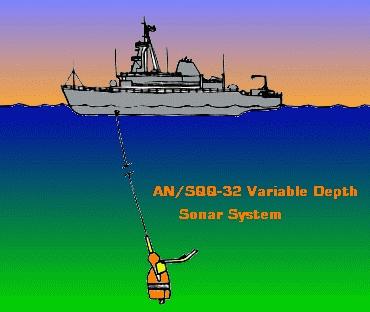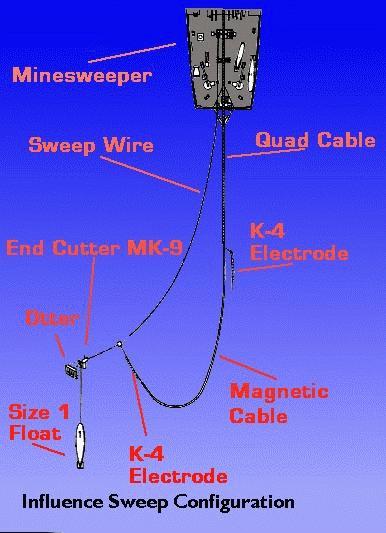


Mine Neutralization
Mine Countermeasures involve any activity used to prevent or reduce the danger to submarines and surface ships from mines. Methods for minimizing the threat of mines can be divided into two basic schools; passive and active countermeasures. Passive countermeasures involves reducing a ship's acoustic and magnetic signature to prevent mines from detecting it. The avoidance of known mines is another method of mine countermeasures.
Active Countermeasures involve minehunting and minesweeping. Minehunting is classified as the systematic detection and elimination of mines one at a time. Minesweeping is the clearing of a pre-defined area, eliminating whatever mines may be deployed there.
Minehunting
 Minehunting is accomplished by towed minehunting sonar arrays and magnetometers. The minesweeping vessel moves across the water with its sonar active until it finds a mine or determines the area is safe. Modern sonar equipment can not only locate mines, but determine their type as well. Final classification of a mine is usually accomplished by a diver or remotely operated vehicle. Once a mine is located, it is neutralized by placing explosives on or near the mine, which has the effect of crippling the mine's detonation electronics or flooding the mine with water, effectively destroying it.
Minehunting is accomplished by towed minehunting sonar arrays and magnetometers. The minesweeping vessel moves across the water with its sonar active until it finds a mine or determines the area is safe. Modern sonar equipment can not only locate mines, but determine their type as well. Final classification of a mine is usually accomplished by a diver or remotely operated vehicle. Once a mine is located, it is neutralized by placing explosives on or near the mine, which has the effect of crippling the mine's detonation electronics or flooding the mine with water, effectively destroying it.
Minesweeping
Minesweeping can be performed by ships or aircraft. There are several types of minesweeping.
Mechanical Sweeps are designed to sever the cables of moored mines. In this case, a sweep wire is towed by the minesweeper with the objective of snagging the tether cables of mines and then severing these cables through abrasive action or with explosive cutters located along the sweep wire. Severed mines float to the surface and may be dispatched by gunfire or EOD team. Bottom mines may be dragged away from a minefield using nets, although this method is seldom used.

Influence Sweeps involve simulating the passage of a ship in order to "fool" the mines into detonating. In this case, a magnetic or acoustic sweep system is towed by a ship or aircraft. Mines that detect the simulated ship detonate themselves.

A magnetic sweep utilizes a magnetic field to simulate the field created by a passing ship. A magnetic field can be produced via an electrical current passing between two non-insulated cables. This resulting field will induce magnetic mines to detonate.
An acoustic sweep is accomplished by simulating the sounds created by a target ship. Various noise makers utilizing compressed air, explosives, hammers or propellers are towed near acoustic mines to detonate them.
Pressure Minesweeping involves sending a large object such as a barge or derelict ship into a minefield to purposely strike mines. This method is not currently practiced.
Combinations of different methods of countermeasures is called a combination sweep. A common combination is a magnetic/acoustic sweep, which simulates the sound and magnetic field of a passing ship.
Sources and Resources
http://www.fas.org/man/dod-101/sys/ship/weaps/mine_sweep.htm
Maintained by Robert Sherman
Originally created by John Pike
Updated Tuesday, December 07, 1999 1:52:19 PM
 Minehunting is accomplished by towed minehunting sonar arrays and magnetometers. The minesweeping vessel moves across the water with its sonar active until it finds a mine or determines the area is safe. Modern sonar equipment can not only locate mines, but determine their type as well. Final classification of a mine is usually accomplished by a diver or remotely operated vehicle. Once a mine is located, it is neutralized by placing explosives on or near the mine, which has the effect of crippling the mine's detonation electronics or flooding the mine with water, effectively destroying it.
Minehunting is accomplished by towed minehunting sonar arrays and magnetometers. The minesweeping vessel moves across the water with its sonar active until it finds a mine or determines the area is safe. Modern sonar equipment can not only locate mines, but determine their type as well. Final classification of a mine is usually accomplished by a diver or remotely operated vehicle. Once a mine is located, it is neutralized by placing explosives on or near the mine, which has the effect of crippling the mine's detonation electronics or flooding the mine with water, effectively destroying it.




